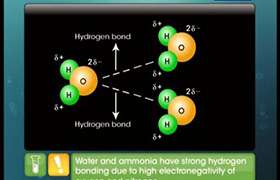CBSE Class 11-science Answered
what are polar and non polar elements?
also tell me about dipole moment
Asked by thakursonali2000 | 20 Nov, 2015, 04:33: PM
'Polar' means the separation of the positive and the negative charge.
A bond between 2 nonmetal atoms that have different electronegativities and therefore have unequal sharing of the bonding electron pair. Therefore the covalent bond between them is considered as polar. Example: HCl
'Non-polar' means the symmetrical distribution of charge such that there is no separation of charges.
A bond between 2 nonmetal atoms that have the same electronegativity and therefore have equal sharing of the bonding electron pair. Therefore the covalent bond between them is considered nonpolar. Example: Homonuclear molecules like Cl2, H2.
In case of multiple questions within a query, please post each question individually and let us know where you are getting stuck so that we would be able to explain things better.
Answered by Hanisha Vyas | 20 Nov, 2015, 04:58: PM
Concept Videos
CBSE 11-science - Chemistry
Asked by neerudhawanbpsmv | 28 Jun, 2021, 09:22: AM
CBSE 11-science - Chemistry
Asked by swatipuspapatel | 10 Jun, 2020, 06:19: PM
CBSE 11-science - Chemistry
Asked by vanyashree106 | 13 Dec, 2019, 09:38: PM
CBSE 11-science - Chemistry
Asked by Asif.k1992 | 12 Sep, 2019, 02:41: PM
CBSE 11-science - Chemistry
Asked by ajitbhot73 | 25 Aug, 2019, 11:52: AM
CBSE 11-science - Chemistry
Asked by design1.bharatifire | 21 Jun, 2019, 06:35: PM
CBSE 11-science - Chemistry
Asked by anitabahuguna | 04 May, 2019, 09:57: PM
CBSE 11-science - Chemistry
Asked by Jatinaa786 | 19 Sep, 2018, 02:53: AM
CBSE 11-science - Chemistry
Asked by arjunshrivastav668 | 17 Mar, 2018, 10:21: AM
CBSE 11-science - Chemistry
Asked by Topperlearning User | 04 Jun, 2014, 01:23: PM




